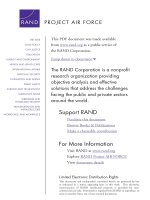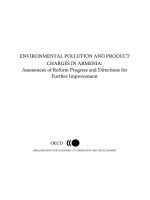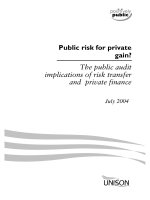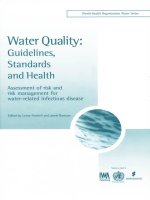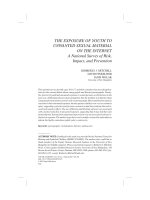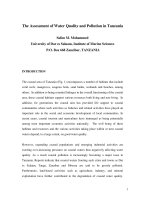New onset diabetes after transplantation assessment of risk factors and clinical outcomes
Bạn đang xem bản rút gọn của tài liệu. Xem và tải ngay bản đầy đủ của tài liệu tại đây (488.56 KB, 5 trang )
New-Onset Diabetes After Transplantation: Assessment of Risk
Factors and Clinical Outcomes
P. Cotovio, M. Neves, L. Rodrigues, R. Alves, M. Bastos, C. Baptista, F. Macário, and A. Mota
ABSTRACT
Background. New-onset diabetes after transplantation (NODAT) is a serious complicatin of kidney transplantation (KT) with adverse impacts on graft and patient survivals.
This study aims assess potential risk factors for development of NODAT and compare
clinical outcomes of KT recipients with versus without NODAT.
Methods. We retrospectively evaluated 648 patients who underwent KT between 2005
and 2009. From the 83 (12.8%) subjects who developed NODAT, we selected 47 for
comparison with controls free of diabetes.
Results. The diagnosis of NODAT was made at 4.3 Ϯ 8.5 months after transplantation
in 47 patients, including 76.6% males, with an overall mean age of 54.5 Ϯ 10.8 years.
Patients with NODAT presented higher pretransplantation fasting plasma glucose levels
(P Ͻ .001) as well as cyclosporine and tacrolimus trough levels (P ϭ .003 and P Ͻ .001,
respectively). On multivariate analysis, higher pretransplantation fasting plasma glucose
and higher tacrolimus, but not cyclosporine concentrations were independent predictors of
NODAT. No differences were found for other potential risk factors. Upon follow-up at 6,
12, 24, 36, 48, and 60 months, renal function (estimated Glomerular Filtration Rate using
Modification of Diet in Renal Disease), 24 hour proteinuria and proportions of patients
with hypertension were similar between groups. Patients with NODAT showed comparable numbers of hospitalizations and infections, as well as acute rejection episodes and
acute cardiovascular events as their counterparts. Event-free survival (loss of graft
function/death with functioning graft) was similar between the groups (P ϭ .418; K-M).
Discussion. In our population, higher pretransplantation fasting plasma glucose levels
and higher tacrolimus concentrations were independent predictors of NODAT. During a
mean follow-up of 3 years, NODAT was not associated with worse clinical outcomes.
EW-ONSET diabetes after transplantation (NODAT)
is a multifactorial, complex metabolic disorder that
has been reported to occur in 2% to 53% of all organ
transplant recipients1,2 and 4% to 25% of kidney transplantation (KT) cases.2 The variation in this incidence may be
due in part to the lack of a standard definition, the
follow-up duration, the presence of modifiable and nonmodifiable risk factors, as well as the type of organ transplantation.2 Although most patients develop diabetes with
in the first 3 months after transplantation, the incidence of
NODAT increases with follow-up period.3,4
NODAT has been associated with impaired long-term
graft function, reduced recipient survival, increased risk of
cardiovascular disease (CVD), and infectious complications.5 KT recipients who develop NODAT are at a two- to
N
three-fold increased risk of fatal and nonfatal cardiovascular events compared with nondiabetics.2,6 Several risk factors have been shown to independently predict NODAT.
Nonmodifiable risk factors include older age, nonwhite
ethnicity, male gender, family history of diabetes, presence
From the Department of Nephrology (P.C., M.N., L.R., R.A.,
F.M.), Department of Endocrinology, Diabetes and Metabolism
(M.B., C.B.), and Department of Urology and Renal Transplantation (A.M.), Centro Hospitalar e Universitário de Coimbra,
Coimbra, Portugal.
Address reprint requests to Partrícia Cotovio, Serviço de
Nefrologia, Centro Hospitalar e Universitário de Coimbra - HG,
Quinta dos Vales, 3041-801 São Martinho do Bispo, Coimbra,
Portugal. E-mail:
© 2013 by Elsevier Inc. All rights reserved.
360 Park Avenue South, New York, NY 10010-1710
0041-1345/–see front matter
/>
Transplantation Proceedings, 45, 1079 –1083 (2013)
1079
1080
of HLA A30, B27, and B42, male donor, deceased donor,
increased HLA mismatches, and acute rejection episodes.
The modifiable (or potentially modifiable) risk factors
comprise obesity and other components of the metabolic
syndrome, previous glucose intolerance, hepatitis C virus
(HCV) and cytomegalovirus infections, as well as immunosuppressive drugs.2 Identifying high-risk patients may
improve long-term outcomes by allowing tailoring of
immunosuppression and early institution of lifestyle
modifications. The purpose of our study was to evaluate
the potential risk factors associated with the development of NODAT in KT recipients and to compare
clinical outcomes of patients with NODAT to their
paired recipients without diabetes.
METHODS
We developed a single-center retrospective registry-based study of
all 648 KT recipients, between 2005 and 2009 among whom 83
developed NODAT (12.8%). The occurrence of disease was defined according to the NODAT 2003 International Consensus
Guidelines2 as symptoms of diabetes mellitus and casual plasma
glucose concentrations Ն 200 mg/dL (11.1 mmol/L) or fasting
plasma glucose Ն 126 mg/dL (7.0 mmol/L) or 2-hour plasma
glucose Ն 200 mg/dL (11.1 mmol/L) during an oral glucose
tolerance test. Among those 83 patients, we excluded 36 recipients
whose recipient pair also developed NODAT or for whom only one
kidney was available for transplantation. We included 47 patients
with a diagnosis of NODAT and 47 corresponding paires control
recipients who did not develop the disorder, thereby seeking to
eliminate potential effects deriving from the donor. We only
included the 45 pairs who had a minimum follow-up of 6 months
(mean, 36.6 Ϯ 17.2 (34.5) months; range, 7 to 79.2 months).
Gathered demographic and clinical data included age at transplantation, gender, race, smoking history, body mass index (BMI),
arterial hypertension, dyslipidemia and CVD (coronary, cerebrovascular, peripheral artery disease and/or congestive heart failure),
pretransplantation fasting plasma glucose, HCV serology, chronic
kidney disease etiology (undetermined, glomerular, tubulointerstitial, hypertension/renal vascular, polycystic) and previous renal
replacement therapy (RRT). Arterial hypertension was defined as
systolic blood pressure (BP) Ն 140 mm Hg and/or diastolic BP Ն
90 mm Hg and/or antihypertensive drug use. Dyslipidemia was
defined as total cholesterol Ն 220 mg/dL, triglyceride levels Ն 150
mg/dL and/or need for specific lipid-decreasing therapy. Recorded
transplantation-specific data included donor demographics histocompatibility (number of HLA matches), immunization (peak
serum panel reactive antibody [PRA]) cold ischemic time, antibody
induction therapy, maintenance immunosuppressive regimens, incidence of delayed graft function, and number of acute rejection
episodes treated with pulse steroids up to the time of the diagnosis
of NODAT.
To compare groups regarding the evolution of estimated glomerular filtration rate (eGFR) calculated by the Modification of Diet
in Renal Disease (MDRD) formula, proteinuria and prevalence of
arterial hypertension at 6, 12, 24, 36, 48, and 60 months after
NODAT diagnosis, we collected serum creatinine and 24-hour
proteinuria values. Hospitalizations, infections, acute rejection
episodes, and acute cardiovascular events (acute myocardial infarction, stroke and acute heart failure) were registered for each
patient. Survival analysis focused on graft loss or death with a
functioning graft.
COTOVIO, NEVES, RODRIGUES ET AL
Statistical analysis was performed using SPSS 17.0. Continuous
variables are shown as mean values and standard deviations or a
medians with minimums and maximums. Categorical variables are
shown as numbers and percentages. Quantitative variables were
compared using the Student t and Mann-Whitney U tests; nominal
variables, chi-square tests. Binary logistic regression models analyzed potential risk factors for development of NODAT. For
survival analysis we used the Kaplan-Meier method with log-rank
tests for significance. P values Ͻ .05 are reported as statistically
significant.
RESULTS
The diagnosis of NODAT was made at 4.3 Ϯ 8.5 months
after transplantation (median, 1.4 months) including 87.2%
of cases within the first 6 months. The general characteristics and statistical comparisons between patients who developed NODAT and the control cohort are presented in
Table 1. Baseline recipient characteristics were similar
between the groups with regard to age, gender, race,
smoking history, BMI, dyslipidemia, hypertension, CVD,
HCV serology, chronic kidney disease etiology, as well as
modality and duration of previous RRT. All patients received a deceased donor graft. No significant differences
were observed regarding the proportion of extended criteria donors, peak serum PRA level, number of HLA
matches, cold ischemic time, use of mono/polyclonal antibodies for induction therapy, maintenance immunosuppression therapy (all treated with calcineurin inhibitors at the
time of diagnosis) and incidence of delayed graft function
or number of acute rejection episodes treated with pulse
steroids (P ϭ not significant). Patients who developed
NODAT showed significantly higher pretransplantation
fasting plasma glucose (P Ͻ .001) and both cyclosporine
and tacrolimus concentrations (P ϭ .003 and P Ͻ .001,
respectively). Logistic regression analysis revealed pretransplantation fasting plasma glucose (odds ratio [OR] 1.1, 95%
confidence interval [IC] 1.02 to 1.14, P ϭ .014) and tacrolimus concentrations (OR 1.5, 95% CI 1.19 to 1.90, P ϭ .001)
to act as independent predictors of NODAT, whereas
cyclosporine content lost significance.
The 45 recipient-pairs for follow-up comparisons showed
comparable evolution of renal function with eGFR-MDRD
values (mL/min/1.73 m2) among NODAT versus controls of
53 Ϯ 26 versus 52 Ϯ 44 (P ϭ .84), 61 Ϯ 21 versus 58 Ϯ 22
(P ϭ .48), 62 Ϯ 21 versus 56 Ϯ 21 (P ϭ .16), 62 Ϯ 19 versus
56 Ϯ 20 (P ϭ .20), 63 Ϯ 22 versus 58 Ϯ 26 (P ϭ .45), 64 Ϯ
24 versus 58 Ϯ 29 (P ϭ .65), and 58 Ϯ 10 versus 58 Ϯ 18
(P ϭ .98) at 0, 6, 12, 24, 36, 48, and 60 months, respectively.
Similarly, recipients with NODAT did not display increased
24-hour proteinuria (g): 0.13 Ϯ 0.3 versus 0.13 Ϯ 0.5 (P ϭ
.47), 0.31 Ϯ 0.8 versus 0.12 Ϯ 0.2 (P ϭ .33), 0.44 Ϯ 0.7
versus 0.42 Ϯ 0.9 (P ϭ .92), 0.48 Ϯ 0.9 versus 0.31 Ϯ 0.4
(P ϭ .86), 0.23 Ϯ 0.3 versus 0.69 Ϯ 1.8 (P ϭ .38), and 0.16 Ϯ
0.2 versus 0.11 Ϯ 0.1 (P ϭ .86) at 6, 12, 24, 36, 48, and 60
months, respectively. The proportion of patients with hypertension was similar between groups at 76% versus 61%
(P ϭ .15), 82% versus 71% (P ϭ .21), 86% versus 73% (P ϭ
NEW-ONSET DIABETES AFTER TRANSPLANTATION
1081
Table 1. Characteristics of Patients With NODAT versus the Control group
Characteristic
Age (years)
Age Ͼ 50 years (n, %)
Black race (n, %)
Male gender (n, %)
History of smoking (n, %)
BMI (kg/m2)
Dyslipidemia (n, %)
Arterial hypertension (n, %)
History of CVD (n, %)
Pretransplantation fasting plasma glucose (mg/dL)
Chronic HCV infection (n)
Chronic kidney disease etiology
Undetermined
Glomerular
Tubulointestitial
Hypertension/renal vascular
Polycystic
Previous RRT (n HD)
Time on dialysis (mo)
Previous renal transplantation (n)
Graft type (n cadaveric)
Extended criteria donor (n)
PRA level before transplantation (n)
0% to 24%
Ն25%
Number of HLA matches
Cold ischemic time (hours)
Induction therapy (n, %)
Maintenance immunosuppression with cyclosporine/tacrolimus (n)
Serum cyclosporine trough level (ng/mL)
Serum tacrolimus trough level (ng/mL)
Delayed graft function (n)
Antirejection therapy with steroids* (n)
NODAT (n ϭ 47)
Control Group (n ϭ 47)
P Value
54.5 Ϯ 10.8
34 (72.3%)
7 (14.9%)
36 (76.6%)
8 (17%)
24.5 Ϯ 3.7
29 (61.7%)
35 (74.5%)
8 (21.3%)
102.9 Ϯ 16.1
2 (4.3%)
49.3 Ϯ 14.5
26 (55.3%)
2 (4.3%)
31 (66.0%)
3 (6.4%)
24.0 Ϯ 4.2
27 (57.4%)
28 (59.6%)
10 (21.3%)
91.4 Ϯ 13.3
5 (10.6%)
.18
.086
.08
.254
.109
.536
.674
.125
.60
Ͻ.001
.239
.746
19 (40.4%)
10 (21.3%)
8 (17.0%)
5 (10.6%)
5 (10.6%)
47 (100%)
68.0 Ϯ 38.6
3 (6.4%)
47 (100%)
29 (61.7%)
19 (40.4%)
10 (21.3%)
5 (10.6%)
9 (19.1%)
4 (8.5%)
46 (97.9%)
79.3 Ϯ 67.5
7 (14.9%)
47 (100%)
26 (55.3%)
43 (91.5%)
4 (8.5%)
2.3 Ϯ 1.0
17.5 Ϯ 4.7
32 (68.1%)
10/57
383.5 Ϯ 124.0
11.9 Ϯ 2.9
12 (25.5%)
9 (19.1%)
44 (93.6%)
3 (6.4%)
2.1 Ϯ 1.2
18.0 Ϯ 5.4
33 (70.2%)
13/34
226.8 Ϯ 66.8
8.5 Ϯ 2.5
16 (34.1%)
8 (17.0)
.29
.324
.177
N/A
.53
.694
.607
.67
.823
.472
.003
Ͻ.001
.367
.789
Abbreviations: NODAT, new onset diabetes after transplantation. BMI, body mass index; CVD, cardiovascular disease; HCV, hepatitis C virus; RRT, renal
replacement therapy; HD, hemodialysis; PRA, panel reactive antibody.
*Methylprednisone 500 mg on 3 consecutive days.
.14), 89% versus 82% (P ϭ .44), 91% versus 79% (P ϭ .31),
89% versus 91% (P ϭ .31), 75% versus 100% (P ϭ .35), in
patients with NODAT versus nondiabetics at 0, 6, 12, 24, 36,
48, and 60 months, respectively. Recipients with NODAT
required comparable numbers of hospitalizations (0.57
versus 0.64 ep./y, P ϭ .69) and experienced similar infection
(0.33 versus 0.47 ep./y, P ϭ .32) as their counterparts. Rate
of acute rejection episodes (4.4% versus 17.1%, P ϭ .056)
and acute cardiovascular events (17.8% versus 12.2%, P ϭ
.47) were not greater among the NODAT versus control
group.
During follow-up, 21 patients were transferred to other
transplantation units, including 9 NODAT (20%) and 12
nondiabetic (29%). Only 3 recipients without diabetes
(7.3% versus 0%, P ϭ .07) lost their grafts. Death with a
functioning graft occurred in 4 NODAT recipients (2 CVD
and 2 infections) and 3 nondiabetics (infections) (8.9%
versus 7.3%, P ϭ .79).
Kaplan-Meier analysis showed similar event-free survial
(loss of graft function/death with functioning graft) between
NODAT and nondiabetic groups at 12, 24, 36, 48, and 60
months to be 100% 97%, 94%, 85% and 85% versus 100%,
95%, 89%, 82%, and 74%, respectively (P ϭ .418; KaplanMeier; Fig 1).
DISCUSSION
Evidence suggests that NODAT is associated with impaired
long-term patient survival, partly owing to the increased
risks of CVD and infectious complications, as well as acute
rejection episodes.1,5–10 Although NODAT clearly contributes to overall graft failure rates, the direct effects of
NODAT on allograft survival are difficult to ascertain.11
United States Renal Data System (USRDS) analysis
showed that compared to “no diabetes,” NODAT was
associated with a 63% increased risk of graft failure (P Ͻ
.0001), a 46% increased risk of death-censored graft failure
(P Ͻ .0001) and a 85% increased risk of mortality (P Ͻ
.0001).6 In other studies, when death-censored graft loss is
1082
COTOVIO, NEVES, RODRIGUES ET AL
Fig 1. Kaplan-Meier curve by NODAT
status for event-free survival (log rank P ϭ
.418).
accounted for, NODAT was no longer a significant risk for
graft loss.11–13
During a mean follow-up of 3 years of our population,
NODAT was not associated with worse renal function,
24-hour proteinuria, prevalence of hypertension, acute rejection episodes, acute cardiovascular events, infections and
hospitalizations, as well as event-free survival. In fact, some
published studies corroborate our results. An analysis by
the Organ Procurement Transplant Network/Scientific
Registry of Transplant Recipient (OPTN/SRTS) database
showed pretransplantation diabetes but not NODAT to be
associated with all-cause and cardiovascular mortality during a median follow-up of 548 days.8 In a single-center
study, patients with NODAT displayed similar KaplanMeier survival curves to nondiabetic KT recipients for up to
96 months after which the plots began to diverge as survival
in patients with NODAT suddently deteriorated. Interestingly, a Kaplan-Meier survival plot constructed in the
NODAT group, starting from the time of diagnosis, was
similar to that for transplant recipients who had pre-existing
diabetes when the two plots were superimposed.9 This
finding suggested that KT recipients who developed
NODAT may experience accelerated progression of diabetes-related complications that affect patient survival.11
To improve the outcomes of KT recipients, it is of great
interest to know risk factors that contribute to NODAT
development. Among our population, higher pretransplantation fasting plasma glucose values were an independent
predictor of NODAT. In fact, abnormal glucose metabolism has been reported to be a risk factor for NODAT in
some but not all studies. Examing 490 KT recipients Cosio
et al reported that higher pretransplantation glucose values
were a risk factor for NODAT at 1 year after transplanta-
tion.14 In another study, random blood glucose values
greater than 6 mmol/L portended a greater than 25%
independent risk to develop NODAT.15 In our study,
higher levels of calcineurin inhibitors showed significant
association with NODAT. Multivariate analysis revealed
tacrolimus concentrations to act as an independent predictive risk factor, whereas those of cyclosporine lost significance. Calcineurin inhibitors have been associated with an
increased risk of NODAT. Although clinical trials comparing the incidence of NODAT in cyclosporine- versus tacrolimus–treated recipients have produced mixed results—,
more consistently tacrolimus shows greater diabetogenic
effect.16 –18
We recognize limitations of out study. It was a retrospective and single-center analysis; therefore, the results may
not be able to be generalized. Our sample was small and the
follow-up short, namely, a median of 34.5 months, which
may not be long enough to manifest the detrimental clinical
effects of NODAT. The association between NODAT and
adverse recipient outcomes suggests that treatment of
hyperglycemia may enhance patient and graft survival.
Therefore, screening for glucose dysregulation and for risk
factors with subsequent lifestyle interventions (diet, weight
loss, and exercise) should be systematic in all phases of the
transplantation process, commencing at evaluation.1,19,20
Among high-risk patients, one must consider carefully the
appropriate immunosuppressive regimen.1,19 After transplantation, screening for the development of diabetes
should include monitoring of fasting plasma glucose at least
weekly in the first 4 weeks, then at 3-, 6-, and 12-month
intervals, and annually thereafter.20 Management of NODAT should follow a stepwise approach, beginning with
nonpharmacologic therapy and progression, if necessary, to
NEW-ONSET DIABETES AFTER TRANSPLANTATION
oral agents either alone or in combination with other oral
agents or insulin. A review and dose adjustment of the
immunosuppressive should be undertaken to improve glucose homeostasis.5,20 Self-monitoring of blood glucose,
evaluation of glycated hemoglobin (HbA1c) levels every 3
months, screening, and treatment of other components of
metabolic syndrome, as well as annual screening for diabetic complications are integral parts of NODAT care. A
multifaceted team-oriented approach, including physicians,
nurse-educators, and nutritionists, has the greatest chance
of successfully and safety diagnosing and treating NODAT,
thereby optimizing the health of affected recipients.19
In conclusion, higher pretransplantation fasting plasma
glucose levels and higher tacrolimus concentrations were
independent predictors of NODAT. At a mean follow-up of
3 years, NODAT was not associated with worse clinical
outcomes, possibly related to systematic management and a
multidisciplinary approach.
REFERENCES
1. Davidson J, Wilkinson AH. New-onset diabetes after transplantation 2003 International Consensus Guidelines: an endocrinologist’s view. Diabetes Care. 2004;27:805.
2. Pham PT, Pham PM, Pham SV, Pham PA, Pham PC. New
onset diabetes after transplantation (NODAT): an overview. Diabetes Metab Syndr Obes. 2011;4:175.
3. Montori VM, Basu A, Erwin PJ, et al. Posttransplantation
diabetes: a systematic reivew of the literature. Diabetes Care.
2002;25:583.
4. Allamani M, Sennesael J, Vendemeulenbroucke E. Posttransplantation diabetes mellitus: a long-term retrospective cohort
study. Transplant Proc. 2010;42:4378.
5. Kaposztas Z, Gyurus E, Kahan BD. New-onset diabetes after
renal transplantation: diagnosis, incidence, risk factors, impact on
outcomes, and novel implications. Transplant Proc. 2011;43:1375.
6. Kasiske BL, Snyder JJ, Gilbertson D, et al. Diabetes mellitus
after kidney transplantation in the United States. Am J Transplant.
2003;3:178.
7. Markell M. Clinical impact of posttransplant diabetes mellitus. Transplant Proc. 2001;33 (suppl 5A):19S.
8. Kuo H-T, Sampaio MS, Vincenti F, et al. Associations of
pretransplant diabetes mellitus, new-onset diabetes mellitus after
1083
transplant, and acute rejection with transplant outcomes: an
analysis of the Organ Procurement and Transplant Network/
United Network for Organ Sharing (OPTN/UNOS) database. Am J
Kidney Dis. 2010;56(6):1026.
9. Cosio FG, Pesavento TE, Kim S, Osei K, Henry M, Ferguson
RM. Patient survival after renal transplantation: IV. Impact of
post-transplant diabetes. Kidney Int. 2002;62:1440 –1446.
10. Revanur VK, Jardine AG, Kingsmore DB, Jaques BC,
Hamilton DH, Jindal RM. Influence of diabetes mellitus on patient
and graft survival in recipients of kidney transplantation. Clin
Transplant. 2001;15:89.
11. Sharif A, Baboolal K. Complications associated with newonset diabetes after kidney transplantation. Nat Rev Nephrol.
2012;8:34.
12. Matas AJ, Wilkinson A, Dantal J, et al. Posttransplant
diabetes mellitus and acute rejection: Impact on kidney transplant
outcome. Transplantation. 2008;85:338.
13. Cole EH, Johnston O, Rose CL, et al. Impact of acute
rejection and new-onset diabetes on long-term transplant graft and
patient survival. Clin J Am Soc Nephrol. 2008;3:814.
14. Cosio FG, Kudva Y, van der Velde M, et al. New onset
hyperglycemia and diabetes mellitus are associated with increased
cardivascular risk after kidney transplantation. Kidney Int. 2005;
67(6):2415–2421.
15. Ramesh Prasad GV, Huang M, Bandukwala F, et al. Pretransplantation glucose testing for predicting new-onset diabetes
mellitus after renal transplantation. Clin Nephrol. 2009;71(2):
140 –146.
16. Woodward RS, Schnitzler MA, Baty J, et al. Incidence and
cost of new onset diabetes mellitus among US wait-listed and
transplanted renal allograft recipients. Am J Transplant 2005;3(5):
590 –598.
17. Ekberg H, Tedesco-Silva H, Demirbas A, et al. Reduced
exposure to calcineurin inhibitors in renal transplantation. N Engl
J Med. 2007;357(25):2562–2575.
18. Vincenti F, Friman S, Sceuermann E, et al. Results of an
international, randomized trial comparing glucose metabolism
disorders and outcome with cyclosporine versus tacrolimus. Am J
Transplant. 2007;7(6):1506 –1514.
19. Bloom RD, Crutchlow MF. New-onset diabetes mellitus in
the kidney recipient: diagnosis and management strategies. Clin
J Am Soc Nephrol. 2008;3:S38.
20. Davidson J, Wilkinson A, Dantal J, et al. Diabetes after
transplantation: 2003 International Consensus Guidelines. Transplantation 2003;75:SS3–SS24.
